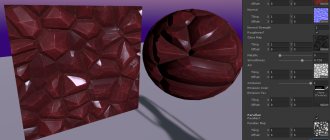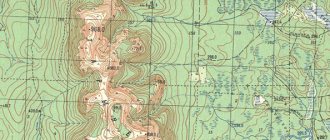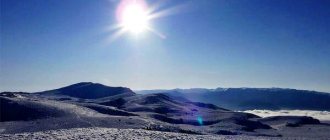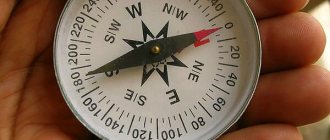The display of relief plays an important role, since it largely determines the nature of all other elements of the content of maps and plans. In addition, the relief affects the water regime, the distribution of vegetation and the spatial distribution of most terrain objects. Without a sufficiently accurate representation of the relief and its detailed study on a map or plan, it is impossible to establish relationships between individual elements of the landscape and, therefore, to rationally use natural resources.
The traditional idea of the terrain on topographic maps and plans is its depiction as contour lines. This method is visual and gives an unambiguous idea of the terrain, allows you to quickly obtain quantitative characteristics of the terrain and solve various applied problems.
Types and forms of terrain
Relief is a set of irregularities on land, the bottom of oceans and seas, varied in outline, size, origin, age and history of development. It is made up of positive (convex) and negative (concave) shapes. The main forms of relief are: mountain, basin, ridge, hollow and saddle.
In addition to the listed forms, the relief has details. Relief details include: ravines, gullies, mounds, embankments, recesses, ledges, quarries, etc. All types of relief shapes and details consist of elements. The main elements of the relief are: base (base), slope (slope), top (bottom), height (depth), steepness and direction of the slope, watershed and drainage lines (thalweg).
In military affairs, terrain refers to the area of the earth's surface on which combat operations are to be conducted. The unevenness of the earth's surface is called terrain, and all objects located on it created by nature or human labor (rivers, settlements, roads, etc.) are called local objects.
Relief and local objects are the main topographical elements of the terrain that influence the organization and conduct of combat, the use of military equipment in combat, conditions of observation, firing, orientation, camouflage and maneuverability, i.e., determining its tactical properties.

A topographic map is an accurate representation of all the most tactically important elements of the terrain, plotted in a mutually precise location relative to each other. It makes it possible to explore any territory in a relatively short time. A preliminary study of the terrain and decision-making for a unit (unit, formation) to carry out a particular combat mission is usually carried out on a map, and then clarified on the ground.
The terrain, influencing combat operations, in one case can contribute to the success of troops, and in another have a negative impact. Combat practice convincingly shows that the same terrain can give greater advantages to those who study it better and use it more skillfully.
According to the nature of the relief, the area is divided into flat, hilly and mountainous.
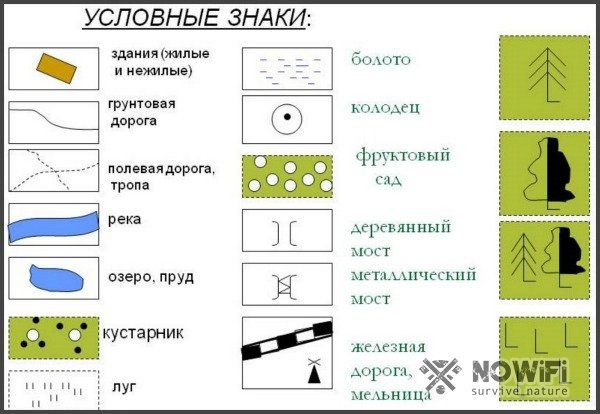
The flat terrain is characterized by small (up to 25 m) relative elevations and relatively low (up to 2°) slope slopes. Absolute heights are usually small (up to 300 m).
The tactical properties of flat terrain depend mainly on the soil and vegetation cover and the degree of ruggedness. Its clayey, loamy, sandy loam, and peat soils allow the unimpeded movement of military equipment in dry weather and significantly complicate movement during the rainy season, spring and autumn thaw. It can be cut up by river beds, ravines and ravines, and have many lakes and swamps, which significantly limit the ability of troops to maneuver and slow down the pace of the offensive.
Hilly terrain is characterized by the undulating nature of the earth's surface, forming irregularities (hills) with absolute heights of up to 500 m, relative elevations of 25 - 200 m and a predominant steepness of 2-3° (Fig. 3, 4). Hills are usually composed of hard rock, their tops and slopes are covered with a thick layer of loose rock. The depressions between the hills are wide, flat or closed basins.
Hilly terrain ensures the movement and deployment of troops hidden from enemy ground observation, facilitates the selection of places for firing positions of missile troops and artillery, and provides good conditions for the concentration of troops and military equipment. In general, it is favorable for both offense and defense.
Mountainous areas are areas of the earth's surface that are significantly elevated above the surrounding terrain (with absolute heights of 500 m or more). It is distinguished by complex and varied terrain and specific natural conditions. The main forms of relief are mountains and mountain ranges with steep slopes, often turning into cliffs and rocky cliffs, as well as hollows and gorges located between mountain ranges. Mountainous terrain is characterized by sharply rugged terrain, the presence of inaccessible areas, a sparse network of roads, a limited number of settlements, rapid river flows with sharp fluctuations in water levels, a variety of climatic conditions, and the predominance of rocky soils.
Combat operations in mountainous areas are considered as actions under special conditions. Troops often have to use mountain passes, making observation and firing, orientation and target designation difficult, at the same time it contributes to the secrecy of the location and movement of troops, facilitates the installation of ambushes and engineering barriers, and the organization of camouflage.
INFLUENCE OF STEPLESS OF SLOPE ON PERFORMANCE
At slight steepness stingrays, the relief of the plains has a minimal impact on the cross-country ability of the terrain and has almost no protective properties.Only deep river valleys, gullies and ravines can serve as shelters from light radiation, penetrating radiation and partially weaken the force of the shock wave of a nuclear explosion. Narrow, deep ravines have the best protective properties. It is generally accepted that a ravine can significantly weaken the damaging effect of a shock wave if its depth is greater than the width at the top and if the depth of the ravine is ten times the height of the object hidden in it.
Tactical properties of stingrays - accessibility for vehicle traffic,
Accessibility of slopes for the movement of cars and pedestrians and
protective properties
The protective properties of slopes from weapons of mass destruction depend not only on their
,
but also on the nature of the soil, moisture and vegetation on the slopes. Based on the steepness, nature of the soil and resistance to the effects of seismic shocks from earthquakes and nuclear explosions, all slopes can be divided into two groups:
- slopes whose steepness is greater than the angle of repose,
- slopes that have a steepness less than the angle of repose.
Slopes whose steepness is equal to or greater than the angle of repose are most often found in mountains.
Soils
| Angles of repose in degrees | ||
| Dry soil | Wet ground | |
| Loess | 50-80 | 10-15 |
| Pebble | 40-45 | 40-43 |
| Gravel | 40-45 | 40-43 |
| Rocky | 45 | 45 |
| Clayey | 45-55 | 15-25 |
| Loamy | 45 | 15-25 |
| Sandy loam | 40-45 | 25-30 |
| Sandy | 30-38 | 22-30 |
| Peat | 35 | 30 |
Note. The angle of repose is the angle formed by the surface of loose soil when it collapses.
Such slopes are in an unbalanced state; their surface, as a rule, is composed of rocky soils and has no vegetation cover. There are many steep areas of varying length and height, as well as screes and stone rivers (kurums).
In summer, massive screes, landslides and rockfalls are observed on such slopes, and in winter - snow avalanches. The reason for this may be earthquakes, explosions of nuclear and conventional weapons. Mountain landslides, rockfalls, scree and snow avalanches cover up or destroy road surfaces, disrupt communication lines, damage defensive structures, dam rivers, etc. All this naturally limits maneuver and slows down the pace of troops' advance.
Active screes, widespread on mountain slopes (not overgrown with grass or forest), have maximum slope angles: sandy - 32-33°, crushed stone - 35-36°, rocky - 36-40°.
Snow avalanches occur on slopes with a steepness of 15-60° with a snow cover of more than 30-40 cm. The probability of avalanches depends on the condition of the snow and the steepness of the slope. For example, old snow lies steadily on slopes of 30°, and avalanches of wet snow sometimes fall from slopes of only 15°.
Slopes whose steepness is less than the angle of repose are more stable. The surface of such slopes is composed of fine-grained soils, turfed and covered with vegetation. There are almost no landslides on them, few screes and landslides.
In general, in mountainous areas the slopes are steeper than in the plains; The higher the mountains, the greater the prevailing steepness of the slopes.
The predominant steepness of the slopes and other characteristics of mountains of different heights can be judged from the data in the table
| Type of mountains | Absolute height, m | Absolute height, m | The predominant steepness of the slopes in degrees |
| Low | 500 — 1000 | 200 — 500 | 5 — 15 |
| Medium high | 1 000 — 2 000 | 500 — 1 000 | 10 — 25 |
| High | more than 2,000 | more than 2,000 | 20 — 45 |
Driving speed on off-road terrain depending on the steepness of the slopes (on dry, hard ground)
| Machine type | Movement speed (km/h) at slope steepness, degrees | |||
| 3-6 | 6 — 10 | 10 — 15 | 15 — 20 | |
| Cars | 20 — 15 | 15 — 12 | 12 — 8 | 8 — 5 |
| Tanks | 15 — 12 | 12 — 10 | 10 — 6 | 6 — 4 |
| Armored personnel carriers, tracked tractors | 12 — 10 | 10 — 7 | 7 — 5 | 5 — 3 |
The essence of depicting relief on maps using contour lines
Relief is the most important element of the terrain, determining its tactical properties.
The image of the relief on topographic maps gives a complete and fairly detailed idea of the unevenness of the earth's surface, the shape and relative position, elevations and absolute heights of terrain points, the prevailing steepness and length of the slopes.
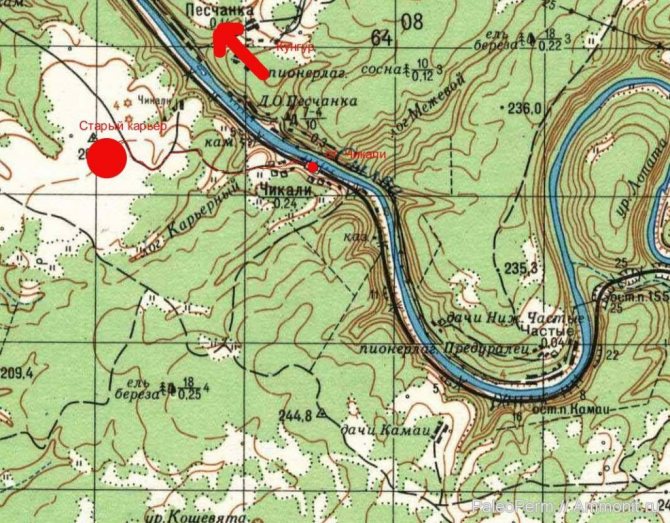
The relief on topographic maps is depicted by contour lines in combination with conventional signs of cliffs, rocks, ravines, gullies, stone rivers, etc. The relief image is supplemented by elevation marks of characteristic points of the area, signatures of contour lines, relative heights (depths) and directional indicators of slopes (berg strokes) . On all topographic maps, the relief is depicted in the Baltic height system, that is, in the system of calculating absolute heights from the average level of the Baltic Sea.
Determining the steepness of slopes using an approximate formula.
The steepness of the slope can also be determined by measuring steps using an approximate formula.
Slope slope = 60 / PS
where ПШ is the length of the slope measured in pairs of steps.
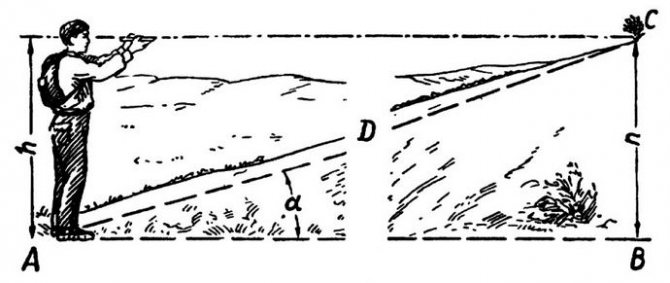
To determine the steepness of the slopes using this formula, the observer stands at point A. Holding a folder or book horizontally at eye level, he looks along it and notices point C on the slope, equal in height to the observer to eye level. Then, moving towards this point, measure the number of pairs of steps and use the formula to determine the steepness of the slope. For example, 4 pairs of steps are counted from point A to point C; slope slope = 60 / 4 = 15 degrees .
Types of contours
Horizontal is a closed curved line on a map, which corresponds to a contour on the ground, all points of which are located at the same height above sea level.
The following horizontal lines are distinguished:
- main (solid) - the relief section corresponding to the height;
- thickened - every fifth main horizontal line; stands out for ease of reading the relief;
- additional horizontals (semi-horizontals) - drawn by a broken line at a height of the relief section equal to half the main one;
- auxiliary - depicted by short, broken, thin lines at an arbitrary height.
The distance between two adjacent main horizontal lines in height is called the height of the relief section. The height of the relief section is indicated on each sheet of the map under its scale. For example: “Continuous horizontal lines are drawn every 10 meters.”

To facilitate the calculation of contours when determining the heights of points on the map, all solid contours corresponding to the fifth multiple of the section height are drawn thickly and a number is placed on it indicating the height above sea level.
In order to quickly determine the nature of surface irregularities on maps when reading a map, special slope direction indicators are used - berg strokes - in the form of short lines placed on horizontal lines (perpendicular to them) in the direction of the slopes. They are placed on the bends of horizontal lines in the most characteristic places, mainly at the tops of saddles or at the bottom of basins.
Additional horizontals (semi-horizontals) are used to display characteristic shapes and details of the relief (bends of slopes, peaks, saddles, etc.), if they are not expressed by the main horizontals. In addition, they are used to depict flat areas when the gaps between the main contour lines are very large (more than 3 - 4 cm on the map).
Auxiliary horizontal lines are used to depict individual relief details (saucers in steppe regions, depressions, individual hillocks on flat terrain), which are not conveyed by the main or additional horizontal lines.
Depiction of typical relief forms by horizontal lines
Relief on topographic maps is depicted by curved closed lines connecting terrain points that have the same height above the level surface, taken as the beginning of the height reference. Such lines are called horizontals. The image of the relief with horizontal lines is supplemented by captions of absolute heights, characteristic points of the terrain, some horizontal lines, as well as numerical characteristics of relief details - height, depth or width.
Determination of absolute heights and relative elevations of terrain points on the map
Profile is a drawing depicting a section of terrain with a vertical plane.
For greater expressiveness of the terrain, the vertical profile scale is taken to be 10 or more times larger than the horizontal one.
In this regard, the profile, conveying the mutual elevation of the points, distorts (increases) the steepness of the slopes.
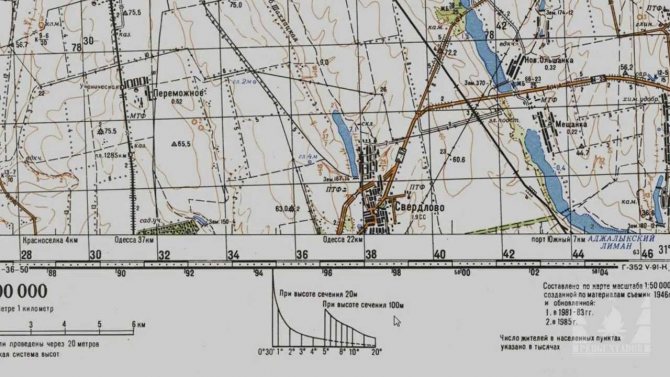
To build a profile you need:
- draw a profile line (route of movement) on the map, attach a sheet of graphed (millimetre) paper to it, transfer to its edge with short lines the places of contour lines, inflection points of slopes and local objects that the profile line cuts, and label their heights;
- sign on a sheet of lined paper at the horizontal lines the heights corresponding to the heights of the contour lines on the map, taking the spaces between these lines as the height of the section (set a vertical scale);
- from all the lines indicating the intersection of the profile line with the marks of the heights of the horizontal lines, inflection points of the slopes and local objects, lower the perpendiculars until they intersect with the parallel lines corresponding to the marks and mark the resulting intersection points;
- connect the intersection points with a smooth curve, which will depict the terrain profile (ascents and descents along the route).
